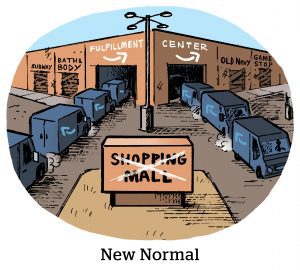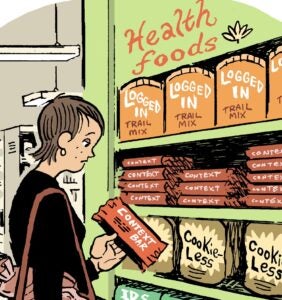 The pandemic upended consumer buying habits – and the brands behind these products are not going back to their old ways.
The pandemic upended consumer buying habits – and the brands behind these products are not going back to their old ways.
Many of the world’s largest food and beverage brands reported quarterly earnings in the past two weeks, and two important themes running throughout those calls was the sharp increase in advertising spend this year and how data is reconfiguring their supply chains, from what products they make straight through to sales and even home delivery.
The rise in media and marketing is hardly a surprise, particularly in terms of year-over-year comparisons. Q2 last year was a time of belt-tightening for ad departments.
But it’s also increasingly clear that changes made in response to the pandemic – a shift in investment from retail to online delivery and orders, say, or conversion-based budgeting for media spend – are likely to remain in place, or have even become priorities moving forward.
Shoppers will return to stores. People will once again reach their bare hands into a box of candy bars in front of a cash register.
But in the meantime, brands are spending more on advertising and using data to guide them in the ‘new normal.’
Media matters
The concept of “working media” rarely used to enter the conversation among CEOs and CFOs, but it came up on multiple CPG earnings calls.
One Mondelez investor asked the management team to provide detail on the company’s forecast for a rapid rise in investment levels in the second half of the year: Is that going to be spent on packaging and production? Will it target certain categories or geographies?
“It is about more working media more than anything else,” said CFO Luca Zaramella. Mondelez is extracting non-working media expenses, such as tech, agency and ad production costs, he said. But the company is also fighting to hold onto household market share gains last year, since more people started snacking at home.
“We continue investing in new packaging, in quality, etc. But the overwhelming part of the investment is around working media,” Zaramella said
Kraft-Heinz spent $100 million more on marketing in Q2 compared to last year and will increase that rate in the second half of 2021, said CEO Miguel Patricio.
“I think it’s not only about increasing marketing, it’s really about efficiencies,” he said.
In 2021, Kraft-Heinz is reaching 30% more of its target consumers at the same level of marketing spend, he said. In the past year, the company has created 12 internal agency hubs covering 30 global markets, which are bringing down the cost of production and the time it takes to create a campaign.
Procter & Gamble, the world’s largest ad spender, will increase advertising by $850 million this year, CFO Andre Schulten told investors. “We’ve not reached the point of diminishing returns on those investments.”
First-party data and analytics
The ad budget increases this quarter are likely to be sustainable, too, because they’re connected more closely to analytics.
As companies collect more first-party data directly on customers, that data reliably leads to more and better marketing.
One example of how P&G now uses data to connect its advertising, go-to-market logistics and profitability is its line of fabric softener.
P&G holds a 37% household market share for its laundry fabric softener, and only 52% of those customers use liquid softener with the detergent in every load, said P&G CEO David Taylor. With clearer visibility into its own household-level market share, P&G can effectively target people with ads about the benefit of consistently using fabric softener. Those ads won’t necessarily add as many net new customers, but they generate stronger profitability across the portfolio of products
The at-home carbonated drink brands SodaStream, which Pepsi acquired in 2018, is a data hub for the company because it’s often sold direct-to-consumer, and it leads to consistent home delivery orders for the gas canisters used to make fizzy drinks.
This year, SodaStream launched special flavor enhancement drops branded by bubly, another of Pepsi’s sugar-free soda brands.
“We continue to build the direct-to-consumer model, trying to get many more insights on consumption behaviors,” said Pepsi CEO Ramon Laguarta. “That is helping us not only to develop the SodaStream business, but to develop the rest of our innovation and categories.”
Direct to Business
For many brands, even the largest CPG brands, going direct to consumer is not a viable option.
Delivering a six-pack of soda or a bottle of ketchup to someone’s door is not profitable, unless it’s part of a large order or is aggregated by a retailer.
But brands are getting into DTC sales through partnerships or B2B deals, where these companies already have significant leverage.
Kraft-Heinz US President Carlos Abrams-Rivera said that one promising vehicle for the company to enter the DTC market is to go directly to home meal kit sellers. One popular DTC meal kit is working with Kraft-Heinz now to develop recipes using its brands, such as Philadelphia cream cheese, he said.
Kraft-Heinz knows how to market at scale, so it can effectively drive potential new business to those meal kits. But it doesn’t need to take on the challenge and hassle of fulfillment itself.
Coca-Cola is testing DTC fulfillment, but as an extension of a digital B2B product called Wabi. Bottlers and retailers use Wabi to re-order and stock Coca-Cola products, but in some Latin American markets the app is also available to consumers, who can place orders and then local stores will make the delivery (shifting the burden of fulfillment off of Coca-Cola).
CEO James Quincey said Coca-Cola’s DTC offering only works in dense cities, where local stores can easily hop on a bike to make a delivery. But the brand also holds first-party data rights from the app. Coca-Cola doesn’t own the purchase data when customers order its products off, say, Instacart.
Eventually, Wabi could be a revenue generator as a platform for other fast-moving consumer brands, Quincey said. If it gains adoption, other snacking and home supply brands that are typically sold in grocery or convenience stores could add their products as well.
AB InBev, the world’s largest beer brewer and one of the biggest beverage companies, rolled out a mobile app called BEES last year that retailers can use to select brands they carry and restock inventory. BEES is only live in 12 markets, but as AB InBev’s preferred method for B2B orders (selling to grocers and convenience stores, resorts, stadiums, etc.) it already represents the majority of all revenue in those markets. In some, BEES accounts for more than 90% of revenue, according to CEO Michael Doukeris. The BEES app processed $4.5 billion in Q2 this year, up by $1.5 billion from the previous quarter alone.
Whether the sales are B2B or DTC, the data now flows back to one consolidated database, where individuals and B2B resellers have a persistent identity.
Doukeris said that each individual consumer or business it adds to that database is a “stepping stone” for the company, because with scale it can test marketing campaigns, product launches and other important business decisions with one-to-one messaging or services. He said it also improves the performance of DraftLine, AB InBev’s in-house agency.
B2B sales may not seem relevant for an internal ad agency, but Doukeris said it creates a wealth of data about what’s popular and what products are purchased together at a city or local level.
“This journey is just at the beginning,” he said. “And I believe that we can unlock a lot of value and resources for us to fund our growth journey.”















